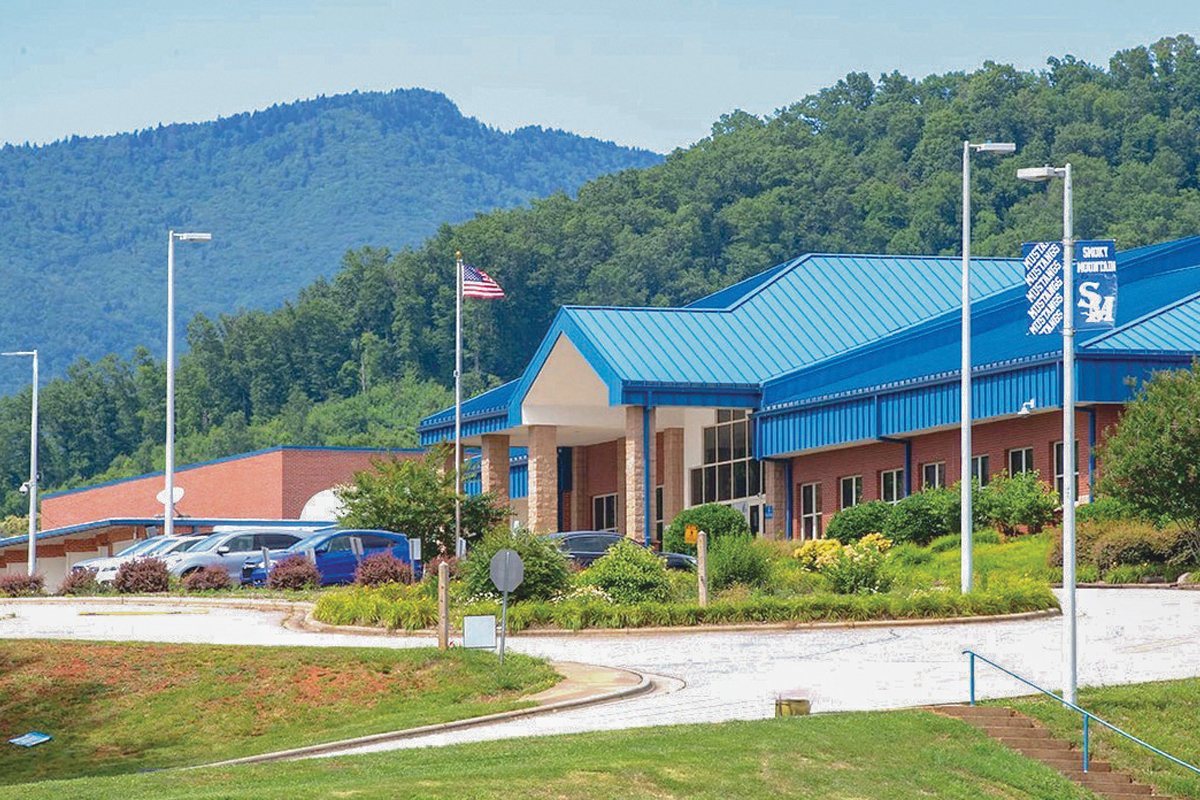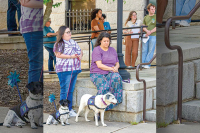'Busting at the seams': JCPS reconsiders partnership with Catamount School
 JCPS photo
JCPS photo
The memorandum of understanding between Jackson County Public Schools and the Catamount School is up for annual review, and this year, JCPS is reconsidering the agreement that permits the Catamount School to operate on the campus of Smoky Mountain High School, where it occupies valuable classroom space in a system that needs all the room it can get.
“One of the things that we need is space,” said Superintendent Dana Ayers. “We need classroom space.”
The Catamount School is a laboratory school operating on the campus of Smoky Mountain High School.
In 2016, the North Carolina General Assembly passed a law that required the University of North Carolina Board of Governors to establish eight lab schools aimed at improving student performance in low-performing schools.
The UNC system selected universities to utilize their colleges of education to establish and operate these lab schools. The Catamount School in Jackson County is run by Western Carolina University’s College of Education.
The lab school opened in 2017 and since that time, the Jackson County Board of Education has not received an update on the school. With the memorandum of understanding between JCPS and the Catamount School up for its annual renewal, Superintendent Dana Ayers took an opportunity to give a report to the board during its March 19 meeting.
Related Items
Although the lab school operates on the campus of Smoky Mountain High School, it is an entirely separate school system.
According to the legislation, “the mission of a laboratory school shall be to improve student performance in local school administration units with low performing schools by providing an enhanced education program for students residing in those units and to provide exposure and training for teachers and principals to successfully address challenges existing in high needs school settings.”
Just because Western Carolina University is located in Jackson County, it did not have to choose to operate in the county.
“They could choose any school system in the area that they wanted to that had low-performing schools,” said Ayers in her report to the board. “We do have low performing schools and continue to have low-performing schools in Jackson County.”
While testing data for the 2022-23 school year showed eight out of nine schools in the county met or exceeded expected academic growth for the second year in a row, JCPS had four low-performing schools — Blue Ridge Early College, Cullowhee Valley School, Scotts Creek Elementary and Smokey Mountain Elementary.
According to the legislation, students are eligible for admission to lab schools if a student resides in a local school administrative unit in which a lab school is located and meets at least one of the following criteria — they are assigned to a low-performing schools, the student did not meet expected growth in the prior school year based on one or more indicators, the student is a sibling of a child who is eligible under the first two criteria or the student is the child of a lab school employee.
“When you look at those requirements, we have many JCPS students who would be eligible for that,” said Ayers.
However, the legislation also states that if a lab school has not reached enrollment capacity in a program, class, grade level or building by March 1, prior to the start of the next school year the lab school can enroll children who reside in the local school administration unit that do not meet the other criteria.
“One of the things I wanted you to see is that they have the opportunity to fill the school with students who meet that criteria and if they don’t fill it before March 1, they can take other students who don’t meet that criteria,” said Ayers.
The Catamount School does not open its application process until March 1, thus allowing the school to accept students without adhering to the criteria set out in the legislation.
Total capacity for the school is 75, with no more than 25 students accepted annually for each grade six through eight. The school has consistently had between 50-60 students since it opened, and currently has 57 students. Of those, 23% are EC (exceptional children) students and 28% are AIG (academically intellectually gifted) students.
“I would like to point out the purpose of the Catamount School is to serve students that are not making academic progress and growth,” said Ayers. “And it seems that their gifted population is increasing.”
As of 2021, the Catamount School had 10 full-time staff in addition to two consultants connected with the university. Of those staff, six are former JCPS employees.
“Unfortunately, we lose good quality peo ple to go to the Catamount School,” said Ayers.
While there are only between 50-60 students at the Catamount School in any given year, JCPS has lost 171 students to the Catamount School over the years and gained back 96 of those.
Of the 171 students, 55 have transferred from Cullowhee Valley School, 56 transferred from Fairview School, which has never been a low-performing school, 38 have transferred from Scotts Creek to go to the lab school and 17 have gone from Smoky Mountain Elementary.
“They do typically come back to us in high school, but we lose them and their ADM in their middle grades years,” said Ayers.
ADM, or Average Daily Membership, is how the state determines funding levels for public schools in North Carolina. Schools are funded on a per-pupil basis depending on their Average Daily Membership.
Like charter schools, when a student opts to go to the Catamount School instead of Jackson County Public Schools, the money allotted them by the state follows them. Jackson County Public Schools must pay the Catamount School for every student that chooses to attend.
However, while a typical charter school would get the entire per-pupil allotment from the public school system in which it operates, Jackson County Schools retains 30% of the allotment for students attending the Catamount School because JCPS is required to provide transportation and student nutrition for the school.
“We do have an obligation to transport and feed students and it is easier to accommodate when we’re right there on the same campus,” said Ayers.
Since 2017, JCPS has paid more than $400,000 to the Catamount School.
The Catamount School occupies five classrooms and three offices at Smoky Mountain High School and shares gym, lab and cafeteria space.
This comes as the high school is in need of more classroom space. The school system has been in talks with Southwestern Community College to get more in-person instruction at Smoky Mountain High School and Blue Ridge School for the college and career readiness program. These classes are open to all juniors and seniors on their home campus, as opposed to having to drive to SCC.
The school is also working to get an ROTC program, which it will need space for, and it is in need of additional space for the exceptional children program to provide specially designed instruction.
“We’re busting at the seams,” said Ayers, “with being able to expand more opportunities for our high school students.”
Another challenge is the blurred line between the Catamount School and JCPS.
“People in our community are not always clear that that is a completely separate school system,” said Ayers.
Students who attend the Catamount School cannot participate in extracurriculars like sports or arts offered through JCPS.
Following her report, board members asked Ayers to return to the board with additional information about the application process and whether the school is admitting all applicants since it has never reached full capacity. Board members also wanted to know why students are not accepted into the Catamount School from Jackson Community School.
The MOU between the two school systems is up for renewal in June. According to the agreement, JCPS is required to give the Catamount School a 20-day due diligence period of notice if JCPS does not want the Catamount School to continue operating on its high school campus.
“However, I would not want to do that,” said Ayers. “They are our neighbors; we have a partnership, even outside of the Catamount School we have a partnership. So, if this board decided they did not want to house [the school] on campus again, I would want to let them know by the next board meeting to give them fair time to make a decision on what they would want to do further.”













